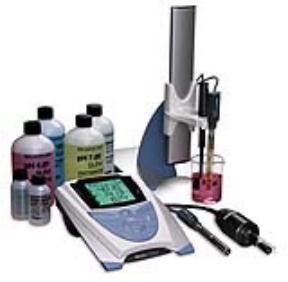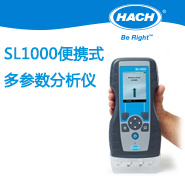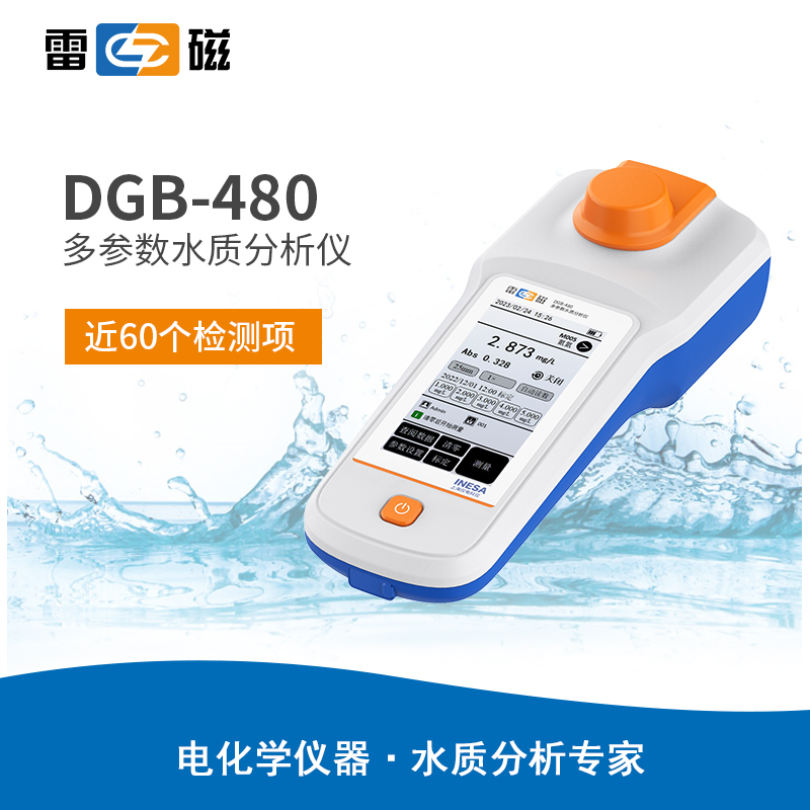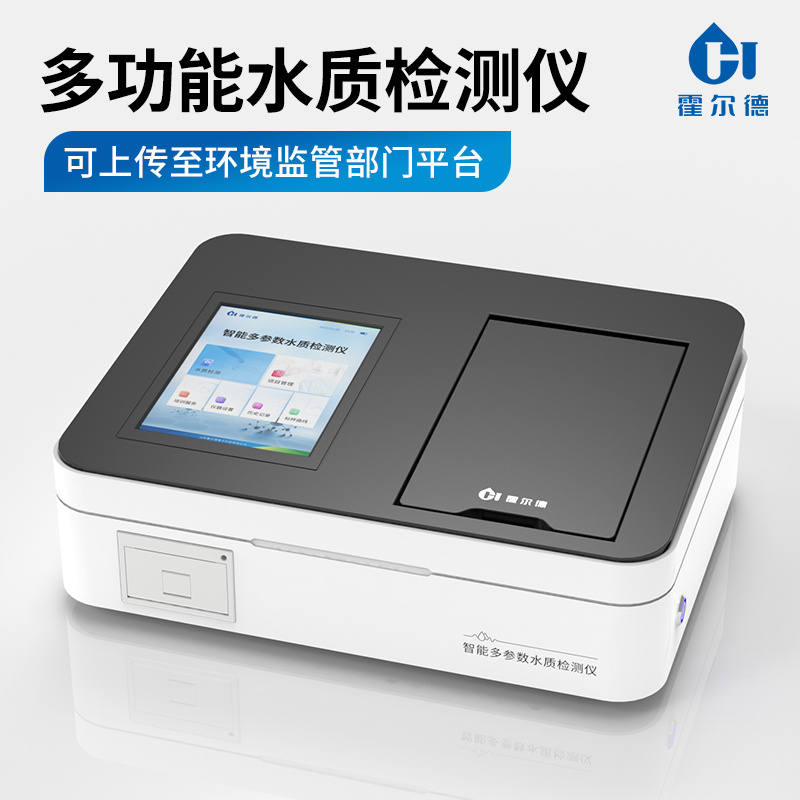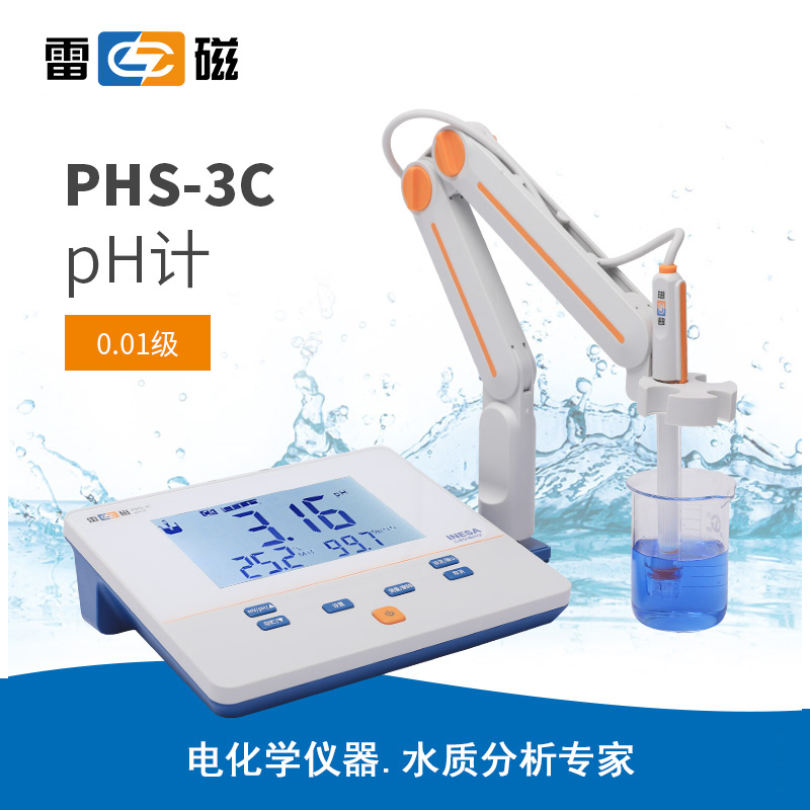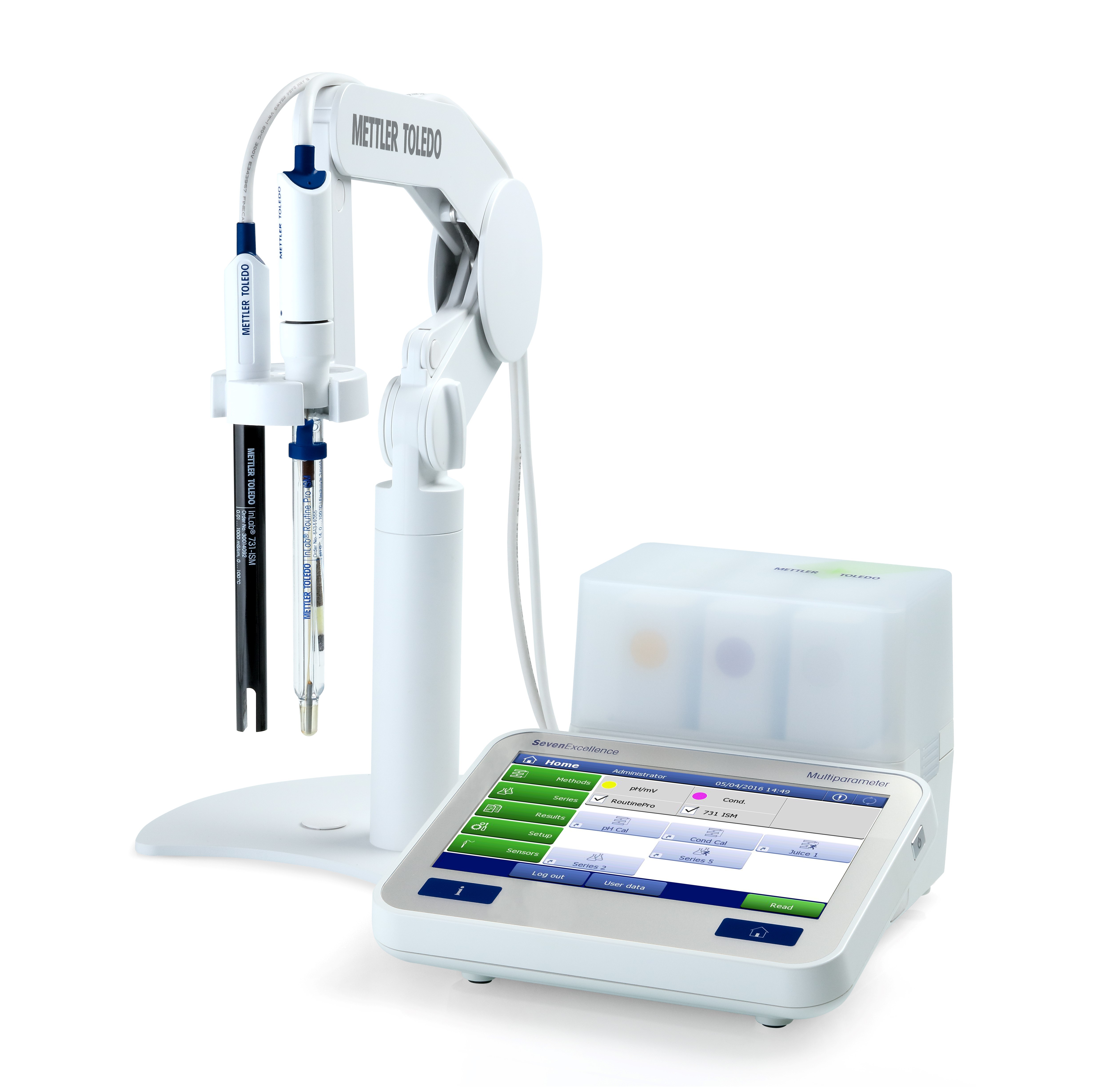方案详情
文
本文章详细介绍了奶酪中pH的测定,包括校准液、水样的准备,校准和测量过程,以及电极和仪表的维护等内容。
方案详情

pH ofCheesepH ofCheese pH ofCheese Star SeriesMethod Note M-1414-E 03/05 RevB Calibration and Analysis ·pH Introduction 1.Allow all the standards and the samples to attain room temperature for precise measurements since themeasurement is temperature sensitive. · Cheese 2. Calibrate the meter using the pH 7.00 buffer followed by the pH 4.01 buffer, stirring the standards at auniform rate. ·ROSSTMpH Electrode The new Orion 3-Star pH meter and ROSS Flat Surface Combination pH electrode (Cat. No. 8135BN)assures cheese and dairy manufacturers the most stable and fast pH measurements for quality assurancepurposes. pH together with temperature, rank as the most important indicators of food quality andsafety. The pH of cheese is measured to ensure that the quality standards have been properly met. pHis also monitored at different stages of cheese processing and transformation to guarantee safety, improveproduction and enhance taste. 3. Place electrode,temperature probe, and stirrer into beaker with pH 7.00 buffer standard such that theelectrode tip is fully immersed in the solution. The stirrer should be positioned slightly below the tip ofthe electrode. Press the STIRRER key on the meter to turn the stirrer on. Press the CALIBRATE key. 4. Wait for stable reading (1-2 minutes). Enter standard value of 7.00 using the UP and DOWN arrowkeys and the DECIMAL/DIGIT key. 5.1Press CALIBRATE key to accept 7.00 standard and press the STIRRER key to turn the stirrer off. 6..Rinse electrode, temperature probe, and stirrer thoroughly with deionized water. Gently remove excesssolution from the outer sleeve of the electrode by dabbing with a clean paper tissue. Do not wipe or rubthe sensing element of the electrode. 7..Place the probes and stirrer into beaker with the pH 4.01 buffer standard such that the electrode tip isfully immersed in the solution. The stirrer should be positioned slightly below the tip of the electrode.Press the STIRRER key on the meter to turn the stirrer on. 8.Wait for a stable reading (1-2 minutes). Enter standard of 4.01 using the UP and DOWN arrow keysand the DECIMAL/DIGIT key. 2. ROSS Combination Flat Surface pH electrode 8135BN 3. Stainless Steel ATC probe 927007MD 4. Orion benchtop stirrer or magnetic stir plate and bar 096019 5. Orion benchtop electrode stand 1110001 9.Press MEASURE key to accept 4.01 standard and to move to the measure mode of the meter. Press theSTIRRER key to turn the stirrer off. 11100017. Graduated cylinder (50 mL)8. Balance9. Knife 10. Rinse electrode, temperature probe, and stirrer thoroughly with deionized water. Gently remove excesssolution from the outer sleeve of the electrode by dabbing with a clean paper tissue. Do not wipe or rubthe sensing element. 10 Blender 11. Place the probes and stirrer into prepared sample such that the electrode tip is fully immersed in thesolution. Press the MEASURE key on the meter; the stirrer will turn on. The pH icon will flash as themeasurement is being made. The pH icon will become solid and the display value will freeze when astable reading is achieved. This value is logged, printed and the stirrer turns off automatically. 12. Repeat steps 10 and 11 for additional samples. Remember to rinse electrodes with deionized water between measurements. Required Solutions Cat. No. 1. pH 4.01 buffer, color coded pink 910104 2. pH 7.00 buffer, color coded yellow 910107 3. pH 10.01 buffer, color coded blue 910110 4. ROSS Reference Filling Solution 810007 5. pH Electrode Storage Solution 910001 Upon completion of samples, rinse the electrode with deionized water and store the electrode according toinstructions in the “Storage"section of this method note. 6.Deionized water Calibration Standard Preparation 1. Using a graduated cylinder, transfer 30 mL of the pH 7.00 buffer into a 50 mL beaker.2. Using a graduated cylinder, transfer 30 mL of the pH 4.01 buffer into a 50 mL beaker. Sample Preparation 1. Cut the cheese sample into small pieces. Weigh 10.0 gram (+0.01) of the cheese sample. 2. Blend the entire contents of the weighed sample with 200 mL DI water. ( Environmental Instruments Water Analysis Instruments ) Toll Free:1-800-225-1480Tel: 1-978-232-6000Dom.Fax: 1-978-232-6015Int'lFax: 978-232-6031 3. Let the sample stand for 5 minutes. www.thermo.com ISO9001:2000 4. Using a graduated cylinder, measure 30 mL of the prepared sample liquid into a 50 mL beaker.5. Measure the pH of the sample. ( 166 Cummi n gs C enterBeverly, MA 01915 USA M - 1 4 14-E 03/05 RevB2 4 8106-0 0 1 ) O 2005 Thermo Electron Corporation 5. Repeat this procedure for additional measurements. All rights reserved 4 of4 Five aliquots of the prepared cheese samples were measured and the results provide representative resultsexpected for pH of cheese Cheese sample pH Sample #1: 5.55 5.56 Sample #2:Sample #3: 5.56Sample #4: 5.57Sample # 5: 5.56 Mean: 5.56 Standard Deviation: 0.010.13 %CV: Electrode Storage To ensure a quick response and free-flowing liquid junction, the sensing element and reference junction mustremain wet and not be allowed to dry out. For short-term storage (up to one week), soak electrode in Orion pH electrode storage solution. (Cat. No.910001). For prolonged storage, the reference chamber should be filled with the fill hole cover in place. Cover thesensing element and reference junction with the protective cap containing a few drops of pH storage solution.After prolonged storage, prepare the electrode as described in the Electrode Setup section of this method. Equipment Setup Electrode Setup-ROSS Combination Flat Surface pH electrode 1.Remove the protective shipping cap from sensing element and save for storage. 2.Clean any salt deposits from exterior by rinsing with deionized water. 3. Uncover filling hole by removing plastic sleeve and add ROSS Internal filling solution. To maintain anadequate flow rate, the level of filling solution must cover the end of coil and be at least one inch above thesample level when immersed. The filling hole should be open whenever the electrode is in use. 4 Place the electrode in the electrode holder and suspend in air for 15 minutes to thoroughly wet thereference junction. Once the junction is wet, do not allow the electrode to dry out. 5. Shake down the electrode to remove air bubbles. 6 Soak the electrode in pH electrode storage solution for one hour. For initial meter setup, follow the steps in the Quick Reference Guide, which is attached to the meter itself.The Quick Start Guide included with each meter also contains a layout of the meter keypad for reference. Thewords in this method represented in all capital letters, such as POWER, indicate a key on the meter, and wordsin quotations such as “Unit"indicate information on the meter display. 1 Connect the electrode to the meter 2. Connect the ATC probe to the meter. 3.Press the POWER key on the meter to turn the meter on. 4.Note that the arrow on the left of the screen indicates the active line. If the top line is not active, press theLINE SELECTION key to change the selected line to the top line. Then press the UP or DOWN arrowkeys to change the measurement mode of the top line to pH. 5.1Press the SETUP key to enter pH setup. Press the LINE SELECTION key to select the middle line. Pressthe UP or DOWN arrow keys to select“rES”, which is resolution. 6.Press the LINE SELECTION key to select the bottom line. Press the UP or DOWN arrow keys to select“0.001” for "rES" which is an abbreviation for resolution or number of significant digits. Press the LINESELECTION key to accept value. 7.P1ress the LINE SELECTION key to select the middle line, and press the UP or DOWN arrow key toselect “bUF”which is pH buffer. 8.Press the LINE SELECTION key to select the bottom line, and press the UP or DOWN arrow key toselect“USA”which is US/Orion buffers. 9. Press the LINE SELECTION key to accept and select the pH setup menu line (top line). 10. Press the MEASURE key to return to the measurement mode. If all steps were followed correctly the meter display will show three digits in the top line and “pH" to the rightof the top line. The meter and electrode are now ready for calibration. Note: The Orion Benchtop Stirrer must be turned on in General Instrument Setupbefore analysis, please see the Quick Start Guide for instructions. of of of
确定

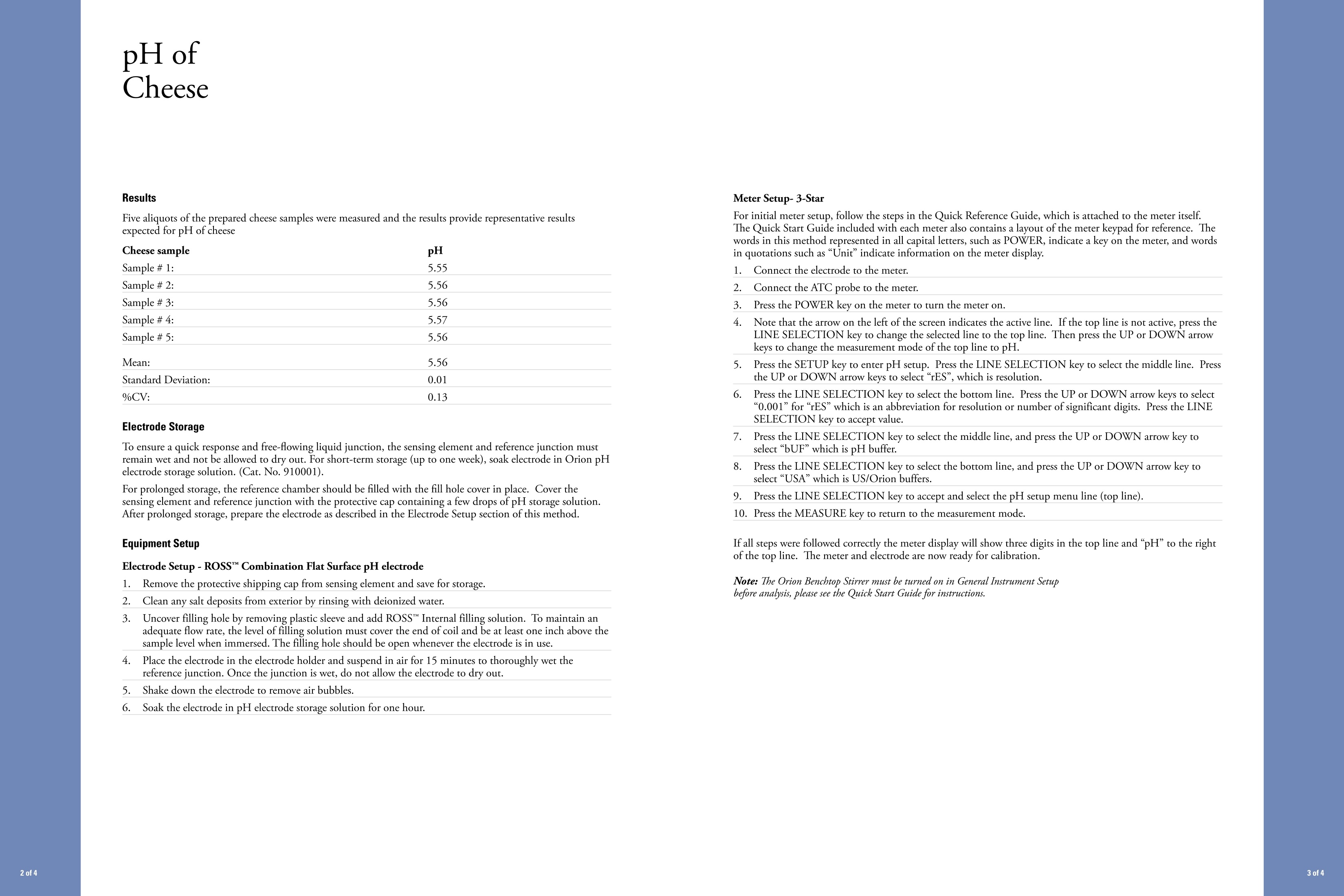
还剩1页未读,是否继续阅读?
赛默飞中国实验室产品事业部为您提供《奶酪中ph检测方案 》,该方案主要用于其他乳制品中理化分析检测,参考标准--,《奶酪中ph检测方案 》用到的仪器有台式pH/ORP/ISE/溶解氧/电导率测量仪、Orion 3-Star台式(便携式)pH/ORP测量仪
推荐专场
水质分析仪/多参数水质分析仪
更多
相关方案
更多
该厂商其他方案
更多

